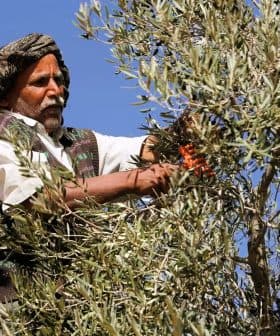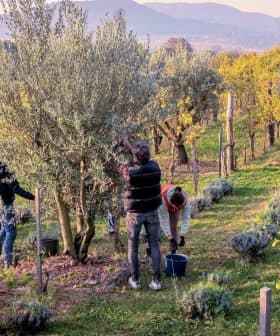 8.8K reads
8.8K readsWorld
Farmers and Consumers React to Rising Olive Oil Prices
Global olive oil export prices reached a record high at the end of April 2023, driven by poor weather and prolonged drought in Spain, the world’s largest olive oil-producing country. High prices are slowing demand from American buyers, and the changing climate is causing issues for olive oil producers and consumers, leading to potential changes in consumer behavior and the need for stronger investments in irrigation technology.
According to commodity pricing data from the International Monetary Fund, global olive oil export prices hit a record high at the end of April.
The IMF’s benchmark extra virgin olive oil export price reached $6,269.63 at the end of April 2023, eclipsing the previous record price of $6,241.91 in December 1996.
As with many other commodities, prices will have to increase as the cost of production does as well.
Export prices are largely driven by prices at origin, specifically in Spain, the world’s largest olive oil-producing country.
Poor weather and prolonged drought continue to push Spanish olive oil prices at origin to their highest levels in the past 26 years. Experts predict record-high prices to continue for the foreseeable future.
See Also:As Spain Fights Food Inflation, Pressures Keep MountingAccording to Reuters, dry weather has resulted in 36 months of low rainfall. Scorching conditions have put Spain’s reservoirs at 50 percent capacity.
Spain’s Ministry of Agriculture, Fisheries, and Food said the country produced only 680,000 tons in the 2022/23 crop year compared to 1.5 million tons in the previous one.
Despite recent rain in southern and eastern Spain, forecasts for the 2023/24 crop year remain grim. Without weather changes, industry experts predict the future harvest could produce another poor yield.
John Cancilla, an economist studying olive oil, told The Washington Post that higher prices are slowing demand from American buyers. “Prices are high, but I don’t see any reasons why they are going to come down,” he said.
Along with Spain, which is responsible for nearly half the world’s olive oil production in any given year, sustained drought resulted in poor harvests across the Mediterranean basin, driving high olive oil prices.
According to the International Olive Council, global olive oil production is expected to fall to 2.73 million tons in the 2022/23 crop year, more than 12 percent below the five-year average, largely due to drought and high springtime temperatures in the Mediterranean basin.
Separate estimates from the United States Department of Agriculture forecast a rebound in production in the 2023/24 crop year to 3.20 million tons. However, USDA economists warned that production might fall below the estimate depending on how the drought in the Mediterranean develops.
Outside of the Mediterranean, California is also struggling with climate change, and like Spain, no relief is in sight.
According to The Washington Post, California farmers are experiencing extremely moist conditions after a deluge of rain. In late winter and early spring, storms blasted through California, producing intense flooding and devastating downpours.
“Weather can make or break the entire season’s production,” Samantha Dorsey, president of McEvoy Ranch in Petaluma, told The Washington Post.
The results are still unknown, as wet conditions may impact a later bloom for the olive crop in California.
Casey Corn, culinary consultant and olive researcher, told Food & Wine Magazine that “the changing climate is absolutely going to result in the volatility of olive production.”
“With uncertain temperature patterns and weather events increasing in intensity, our crops aren’t facing the same predictable environments that we’ve built infrastructure and businesses around,” she added.
The changing climate creates further issues for olive oil producers and consumers. The environment is fundamental to the quality and flavor of the food.
“Flavor is protected with certifications like AOP [Controlled Designation of Origin, in France], PDO [Protected Designation of Origin], DOC [Controlled Designation of Origin, in Italy],” said Corn. “Larger olive producers may need to supplement smaller crops with olives from different locations, which may impact the flavor of the product.”
Olive oil growers are seeking solutions, according to Jennifer LeClair, vice president of purchasing and operations at Pastene, a U.S.-based specialty food importer. “Growers will need stronger investments in irrigation technology for when the weather isn’t cooperating and best for olive growth,” LeClair told Food & Wine Magazine.
Rivulis is one irrigation technology company transforming the way farmers irrigate crops. The pioneering drip irrigation system enables farmers to expand crops, including olives, walnuts, almonds, tomatoes and corn.
In a Rivulus video interview, Luis Javier Fernández Villalobos, a technician at Agrofervi Explotaciones Agrícolas, describes drip irrigation as the key to good crop quality in his Spanish olive orchard.
Successful drip irrigation requires uniformity, which is critical to the crop’s quality, taste and appearance.
“We grow rain-fed and irrigated crops, but mainly irrigated intensive [high-density] crops,” Villalobos said. “Drip irrigation is completely changing the crops we can grow. It guarantees we produce crops of excellent quality.”
While consumers continue to enjoy the benefits of olive oil, rising prices and decreasing volume can inspire new culinary explorations.
“I hope that farmers will continue to innovate as the climate keeps changing,” Corn told Olive Oil Times. “As with many other commodities, prices will have to increase as the cost of production does as well. While consumers are used to a range of prices in olive oils and the ability to prioritize value over quality, this will most likely change.”
“I believe that olive oil has become irreplaceable in American kitchens and that consumers will continue to purchase olive oil,” she added. “We may find that people begin expanding the variety of oils used in their kitchens, and that they start using different oils for different cooking techniques, but that they still purchase olive oil as a familiar, and delicious, product.”









